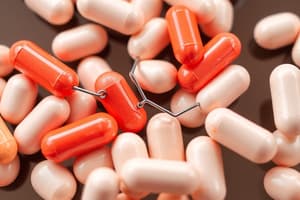Podcast
Questions and Answers
What is the primary action of sulfonamides?
What is the primary action of sulfonamides?
- Increase blood circulation
- Enhance respiratory function
- Stimulate bacterial growth
- Inhibit bacterial synthesis of folic acid (correct)
Which of the following are common adverse effects of trimethoprim-sulfamethoxazole?
Which of the following are common adverse effects of trimethoprim-sulfamethoxazole?
- Increased appetite and fatigue
- Constipation and rash
- Headache and dizziness (correct)
- Hypertension and palpitations
What type of infections is metronidazole indicated for?
What type of infections is metronidazole indicated for?
- Fungal skin infections
- Bacterial and protozoal infections (correct)
- Urinary tract infections
- Viral respiratory infections
What is a key consideration when administering sulfonamides?
What is a key consideration when administering sulfonamides?
What is one of the serious adverse effects associated with trimethoprim-sulfamethoxazole?
What is one of the serious adverse effects associated with trimethoprim-sulfamethoxazole?
What is the mechanism by which penicillins act against bacteria?
What is the mechanism by which penicillins act against bacteria?
Which of the following is a contraindication for using penicillin?
Which of the following is a contraindication for using penicillin?
What adverse effect is associated with the use of penicillins?
What adverse effect is associated with the use of penicillins?
Which type of bacteria does penicillin primarily target?
Which type of bacteria does penicillin primarily target?
What condition can be treated effectively with penicillin?
What condition can be treated effectively with penicillin?
What happens to the effectiveness of oral contraceptives when combined with penicillins?
What happens to the effectiveness of oral contraceptives when combined with penicillins?
What is the primary action of beta-lactamase enzyme inhibitors in relation to penicillins?
What is the primary action of beta-lactamase enzyme inhibitors in relation to penicillins?
What is the primary mechanism of action of cephalosporins?
What is the primary mechanism of action of cephalosporins?
What potential side effect is associated with cefepime?
What potential side effect is associated with cefepime?
In what situation should caution be exercised when using ceftriaxone?
In what situation should caution be exercised when using ceftriaxone?
Which of the following infections can cephalosporins treat?
Which of the following infections can cephalosporins treat?
What common side effect is noted for macrolides like erythromycin?
What common side effect is noted for macrolides like erythromycin?
Which type of bacteria are ceftriaxone and cefepime effective against?
Which type of bacteria are ceftriaxone and cefepime effective against?
What is a notable risk when using certain cephalosporins simultaneously with anticoagulants?
What is a notable risk when using certain cephalosporins simultaneously with anticoagulants?
What type of infections is nafcillin particularly effective against?
What type of infections is nafcillin particularly effective against?
Which of the following is a characteristic of 4th generation cephalosporins?
Which of the following is a characteristic of 4th generation cephalosporins?
What type of infections is Erythromycin effective against?
What type of infections is Erythromycin effective against?
What is a potential side effect of Azithromycin?
What is a potential side effect of Azithromycin?
What does Clindamycin inhibit?
What does Clindamycin inhibit?
In which type of infection is Lincosamides notably ineffective?
In which type of infection is Lincosamides notably ineffective?
What is a common side effect associated with Azithromycin administration?
What is a common side effect associated with Azithromycin administration?
What demographic might require caution when receiving Erythromycin?
What demographic might require caution when receiving Erythromycin?
What is the preferred method of diluting IV Azithromycin?
What is the preferred method of diluting IV Azithromycin?
What syndrome can result from Clindamycin use?
What syndrome can result from Clindamycin use?
What is the route of administration for Clindamycin to avoid GI distress?
What is the route of administration for Clindamycin to avoid GI distress?
What is an important caution regarding the use of Theophylline?
What is an important caution regarding the use of Theophylline?
What is a potential risk associated with the rapid intravenous administration of Vancomycin?
What is a potential risk associated with the rapid intravenous administration of Vancomycin?
Which class of antibiotics is contraindicated during the first and last trimester of pregnancy?
Which class of antibiotics is contraindicated during the first and last trimester of pregnancy?
What adverse effect is associated with the use of Gentamicin?
What adverse effect is associated with the use of Gentamicin?
Which of the following is a common side effect of fluoroquinolones?
Which of the following is a common side effect of fluoroquinolones?
What is the peak action time for Vancomycin after infusion?
What is the peak action time for Vancomycin after infusion?
Which option describes a potential interaction when taking Doxycycline?
Which option describes a potential interaction when taking Doxycycline?
What indicates that the serum levels of Vancomycin are adequate during treatment?
What indicates that the serum levels of Vancomycin are adequate during treatment?
What type of agent is Doxycycline primarily considered?
What type of agent is Doxycycline primarily considered?
Which adverse effect is associated with fluoroquinolones?
Which adverse effect is associated with fluoroquinolones?
How should Gentamicin be administered for optimal effectiveness?
How should Gentamicin be administered for optimal effectiveness?
Flashcards
Amoxicillin mechanism
Amoxicillin mechanism
Amoxicillin works by inhibiting bacterial cell wall synthesis, preventing bacteria from dividing and multiplying.
Penicillin adverse GI effects
Penicillin adverse GI effects
Common side effects of penicillin include nausea, vomiting, diarrhea, and abdominal pain.
Penicillin allergy
Penicillin allergy
A serious allergic reaction to penicillin can occur, including anaphylaxis.
Penicillin indications
Penicillin indications
Signup and view all the flashcards
Penicillin contraindications
Penicillin contraindications
Signup and view all the flashcards
Penicillin interactions
Penicillin interactions
Signup and view all the flashcards
Penicillins and food
Penicillins and food
Signup and view all the flashcards
Nafcillin
Nafcillin
Signup and view all the flashcards
Cephalosporins
Cephalosporins
Signup and view all the flashcards
Ceftriaxone
Ceftriaxone
Signup and view all the flashcards
Cefepime
Cefepime
Signup and view all the flashcards
Macrolides
Macrolides
Signup and view all the flashcards
Gram-positive bacteria
Gram-positive bacteria
Signup and view all the flashcards
Gram-negative bacteria
Gram-negative bacteria
Signup and view all the flashcards
Bacterial Cell Wall
Bacterial Cell Wall
Signup and view all the flashcards
Hypersensitivity
Hypersensitivity
Signup and view all the flashcards
Azithromycin use
Azithromycin use
Signup and view all the flashcards
Azithromycin adverse effect
Azithromycin adverse effect
Signup and view all the flashcards
Clindamycin mechanism
Clindamycin mechanism
Signup and view all the flashcards
Clindamycin indications
Clindamycin indications
Signup and view all the flashcards
Clindamycin adverse effects
Clindamycin adverse effects
Signup and view all the flashcards
Glycopeptides mechanism
Glycopeptides mechanism
Signup and view all the flashcards
Theophylline use
Theophylline use
Signup and view all the flashcards
Theophylline adverse effects
Theophylline adverse effects
Signup and view all the flashcards
Erythromycin mechanism
Erythromycin mechanism
Signup and view all the flashcards
Erythromycin indications
Erythromycin indications
Signup and view all the flashcards
Theophylline increased levels
Theophylline increased levels
Signup and view all the flashcards
Sulfonamides adverse effects
Sulfonamides adverse effects
Signup and view all the flashcards
Trimethoprim-Sulfamethoxazole combo
Trimethoprim-Sulfamethoxazole combo
Signup and view all the flashcards
Nitroimidazoles (Metronidazole) indications
Nitroimidazoles (Metronidazole) indications
Signup and view all the flashcards
Monitoring Theophylline Levels
Monitoring Theophylline Levels
Signup and view all the flashcards
Vancomycin
Vancomycin
Signup and view all the flashcards
Nephrotoxicity
Nephrotoxicity
Signup and view all the flashcards
Ototoxicity
Ototoxicity
Signup and view all the flashcards
Red Man Syndrome
Red Man Syndrome
Signup and view all the flashcards
Tetracyclines
Tetracyclines
Signup and view all the flashcards
Doxycycline
Doxycycline
Signup and view all the flashcards
Aminoglycosides
Aminoglycosides
Signup and view all the flashcards
Gentamicin
Gentamicin
Signup and view all the flashcards
Fluoroquinolones
Fluoroquinolones
Signup and view all the flashcards
Ciprofloxacin
Ciprofloxacin
Signup and view all the flashcards
Study Notes
Antibiotics, Antivirals, Antifungals
-
Penicillins (broad spectrum):
- Action: Beta-lactam ring interferes with bacterial cell wall synthesis.
- Indication: Otitis media, tonsillitis, sinusitis, respiratory and urinary tract infections (gram-positive and gram-negative bacteria), endocarditis.
- Adverse effects: GI: nausea, vomiting, diarrhea, abdominal pain, skin discoloration, superinfection, anaphylaxis.
- Misc.: Allergy, hypersensitivity to cephalosporins, pseudomembranous colitis, ulcerative colitis, GI disease, decreased effect with acidic foods and drinks. May decrease effectiveness of oral contraceptives. Not effective against gram-negative bacteria.
-
Penicillinase-Resistant Penicillins (e.g., Nafcillin):
- Action: Treat penicillinase-producing S. aureus.
- Indication: Endocarditis, meningitis, skin, respiratory, bone/joint infections.
- Adverse effects: GI: abdominal pain, nausea, vomiting, diarrhea, renal impairment, skin stomatitis.
- Misc.: Not effective against gram-negative bacteria.
-
Cephalosporins:
- Action: Inhibits bacterial cell wall.
- Indication: Otitis media, meningitis.
- Adverse effects: GI distress, phlebitis, injection site reaction, elevated.
- Misc.: Caution: hypersensitivity to penicillins.
-
Ceftriaxone (3rd generation):
- Action: antibacterial synthesis causing cell lysis.
- Indication: Gonorrhea, bacteremia, respiratory, bone/joint, abdominal, and urinary tract infections (gram-positive and gram-negative bacteria).
- Adverse effects: Hepatic enzymes, pseudomembranous colitis, nephrotoxicity.
- Misc.: Increased bleeding if used with anticoagulants.
-
Cefepime (4th generation):
- Action: inhibits bacterial cell wall.
- Indication: Bacteremia, respiratory, skin, intraabdominal, and urinary tract infections.
- Adverse effects: GI distress, headache.
- Misc.: Caution: hypersensitivity to penicillins.
-
Macrolides (broad spectrum):
- Action: Bind to 50S ribosomal subunits to inhibit protein synthesis.
- Indication: Respiratory infections
- Adverse effects: GI distress, diarrhea.
- Misc.: Interactions: theophylline, carbamazepine, and warfarin
- Erythromycin, Azithromycin:
- Action: Bacteriostatic (at low concentrations).
- Indication: respiratory infections, pneumonia, GI distress
- Adverse effects: diarrhea, abdominal cramping.
- Misc: "Zpack"- use over 7 days with slow taper.
-
Lincosamides (e.g., Clindamycin):
- Action: Inhibits bacterial protein synthesis.
- Indication: Lower respiratory tract infections, STIs and skin infections.
- Adverse effects: GI distress, bone marrow suppression, pseudomembranous colitis.
- Misc.: Not effective against gram-negative bacteria.
-
Glycopeptides (e.g., Vancomycin):
- Action: Inhibits bacterial cell wall synthesis.
- Indication: Active prophylaxis against severe gram-positive bacteria, bacteremia and C. diff infections
- Adverse effects: Nephrotoxicity, ototoxicity, red man syndrome, cardiac issues, permanent hearing loss, headache, dizziness, fatigue
- Misc.: Monitor levels, peak and trough, dilute IV.
-
Tetracyclines (e.g., Doxycycline):
- Action: Inhibits bacterial synthesis.
- Indication: Respiratory, urinary tract and skin infections, STDs.
- Adverse effects: GI distress, hepatotoxicity, bone damage, teeth staining, rash, photosensitivity
- Misc.: Contraindicated in children under 8, first and last trimester of pregnancy.
-
Aminoglycosides (e.g., Gentamycin):
-
Action: Inhibits protein synthesis, bactericidal.
-
Indication: Serious infections.
-
Adverse effects: Nephrotoxicity, ototoxicity, CNS confusion, disorientation.
-
Misc.: Check peak and trough levels, increased risk of ototoxicity with diuretics.
-
-
Fluoroquinolones (e.g., Ciprofloxacin, Levofloxacin):
-
Action: Interferes with DNA enzymes, necessary for bacterial synthesis.
-
Indication: Urinary tract, bone and joint infections, bronchitis, pneumonia
-
Adverse effects: Elevated CNS effects including headache, dizziness and insomnia, rash GI distress
-
Misc.: Reserved for patients with no alternative treatment options. Take before meals without antiacids.
-
-
Sulfonamides (e.g., Trimethoprim-Sulfamethoxazole):
-
Action: Inhibits synthesis of folic acid, essential for bacterial growth.
-
Indication: Urinary tract, respiratory, ear infections.
-
Adverse effects: GI distress, CNS effects (headache, dizziness, vertigo, ataxia, depression, seizures), hepatotoxicity, nephrotoxicity, bone marrow suppression.
-
Misc.: Combination drug.
-
-
Nitroimidazoles (e.g., Metronidazole):
-
Action: Disrupts DNA and protein synthesis.
-
Indication: Intraabdominal and respiratory infections, H. pylori
-
Adverse effects: CNS effects, GI effects, hepatotoxicity, nephrotoxicity, photosensitivity, rash.
-
Misc.: Given PO, IV, or topically. Avoid ETOH
-
-
Antituberculars (e.g., Isoniazid):
-
Action: Inhibits bacterial cell wall synthesis.
-
Indication: Treat active tuberculosis and prophylaxis.
-
Adverse effects: GI distress, peripheral neuropathy, hepatotoxicity, ocular toxicity.
-
Misc.: Contraindicated: moderate to severe liver disease, Monitor LFTS.
-
-
Antimycobacterials (e.g., Rifampin):
-
Action: Inhibits bacterial cell wall synthesis.
-
Indication: Tuberculosis.
-
Adverse effects: Body fluids may turn orange, hepatotoxicity.
-
Misc.: Given on empty stomach, monitor LFTS.
-
Antifungals (e.g., Fluconazole):
-
Action: Decreases the release of virus from infected cells.
-
Indication: Influenza A and B.
-
Adverse effects: CNS effects, GI and headache.
-
Misc.: given within 48 hours of flu symptoms or exposure.
-
-
Antivirals for Influenza (e.g., Oseltamivir):
-
Action: Decreases the release of virus from infected cells
-
Indication: Influenza A and B
-
Adverse effects: CNS effects, GI distress, fatigue, dizziness. Headache
-
-
Herpes Antivirals (e.g., Acyclovir, Valacyclovir):
-
action: Inhibits viral DNA synthesis
-
indication: Herpes simplex viruses (HSV-1 and HSV-2), chicken pox, shingles
-
adverse effects: GI distress, headache, kidney dysfunction
-
misc.: Monitor kidney function and blood counts, acyclovir can be topical, or oral or IV
-
Antivirals for HIV (e.g., Zidovudine):
-
Action: Inhibits viral reverse transcriptase enzyme and viral replication
-
Indication: Maternal-fetal HIV transmission prevention
-
Adverse effects: Peripheral neuropathy, GI effects, hypersensitivity.
-
-
-
Fluconazole:
-
Action: Inhibits fungal cell wall synthesis.
-
Indication: Cryptococcal meningitis, prophylaxis from BMT, radiation therapy
-
Adverse effects: Headache, rash, anemia, liver toxicity, QT prolongation
-
Misc.: Possible drug interactions
-
-
Lipoatrophy
- Indication: Lipid loss due to chronic use.
-
Misc.: Monitor hepatic function with chronic use.
Studying That Suits You
Use AI to generate personalized quizzes and flashcards to suit your learning preferences.




